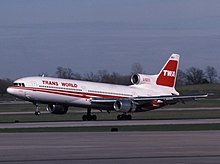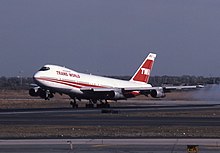Trans World Airlines
Trans World Airlines, commonly known as TWA, was a major American airline. Founded in 1925 under the name Western Air Express, in 1930 it was renamed Trans World Airlines until it was purchased by American Airlines in 2001.
The birth of TWA
The airline was founded on July 13, 1925 as Western Airlines. In 1930 it merged with Transcontinental Air Transport to become Transcontinental and Western Air (TWA).

Howard Hughes purchased TWA in 1939, and the airline grew rapidly under the leadership of Hughes and CEO Jack Frye.
After ending Pan American World Airways' legal designation as the United States' sole international airline, TWA began transatlantic service in 1946 using the new Lockheed Constellation aircraft.
Until the early 1970s, TWA and Pan Am were the only U.S. airlines flying to Europe.
In 1950, the airline changed its name to Trans World Airlines. It established routes from Europe to Asia during the 1950s and 1960s, flying as far away as the Far East: Hong Kong.
In the case of the Transpacific route of 1969, they gave TWA authorization to extend its network also across the Pacific Ocean. TWA was also the main contributor to the founding of Saudi Arabian Airlines and Ethiopian Airlines.
Hughes's increasing eccentricities caused TWA to demand his removal as president of the company in 1961. Under new corporate management, TWA expanded by purchasing the overseas operations of Hilton Hotels. In 1969, TWA's transatlantic operations were smaller than Pan Am's.
TWA accumulated debts until December 1, 2001 when it became part of American Airlines.
Trans World Connection
TWA had a subsidiary: Trans World Connection (or TWConnection). It flew to many destinations within the US, to Quebec, Canada, to Puerto Rico, to the US Virgin Islands, to the Netherlands Antilles, to Saint Kitts and Nevis, and to the British Virgin Islands. Since 2000, Gulfstream International Airlines has been flying under the name TWConnection. Their fleet consisted of Handley Page Jetstreams and Beech 1900s.
Accidents and incidents
Flight 3
On January 16, 1942, a Douglas DC-3 (NC194) from New York bound for Los Angeles crashed near Las Vegas into Mount Potosí, causing the death of its 22 occupants, including the famous actress of the time, Carole Lombard, her mother and her representative.
Flight 903
On September 1, 1950, a Lockheed Constellation covering the Bombay-Cairo-Rome-New York route suffered a fire in engine number 3, forcing it to make an emergency landing in the desert, near Cairo.. The plane crashed during landing, killing all 55 occupants.
Flight 2

On June 30, 1956, another Lockheed Constellation from Kansas with 70 occupants crashed into a United Airlines Douglas DC-7 over the Grand Canyon of the Colorado. All 128 people traveling on both planes died.
It was the worst air accident in history up to that date, being surpassed four years later by the air collision of a Lockheed Super Constellation, also from TWA, with a Douglas DC-8 from United Airlines over New York causing 128 deaths on board the planes and 6 deaths on the ground.
TWA Flight 266
On December 16, 1960, for the third time, a Lockheed Constellation from Ohio with 44 occupants crashed into a United Airlines Douglas DC-8 over Brooklyn. All 128 occupants of both planes and 6 people on the ground died. There was initially one survivor, but he died days later. These two airlines already had an air collision 4 years before.
Flight 529
On September 1, 1961, a Lockheed Constellation en route Boston-New York-Pittsburgh-Chicago-Las Vegas-Los Angeles-San Francisco crashes into the ground near Hinsdale. Its 78 occupants die.
Flight 553
On March 9, 1967, a DC-9 with 25 people collided over Ohio with a Beechcraft Baron private plane with one occupant. All 25 people die.
Flight 841
On September 8, 1974, a bomb exploded on a Boeing 707 that was covering the Tel Aviv-Athens-Rome-New York route. The plane crashes into the Ionian Sea, killing all 88 occupants.
Flight 514
On December 1, 1974, a Boeing 727 with 92 people crashed into Mount Weather, leaving no survivors.
Flight 840
On April 2, 1986, a Boeing 727 that was covering the Rome-Athens route with 121 people suffered a bomb attack. The explosion opened a hole in the fuselage, ejecting four people, but the aircraft was able to make a safe landing in Athens.
TWA Flight 800


On July 17, 1996, a Boeing 747 that had just taken off 12 minutes ago from John F. Kennedy International Airport heading to Paris-Charles de Gaulle Airport, exploded while flying over Long Island. 230 people die. The plane had been parked for 2 and a half hours waiting for confirmation from a passenger on board (fearing a terrorist attack), with the air conditioning at maximum power, causing the fuel in the central tank to overheat almost to the point of ignition. During the flight, damaged cables from the old 747 carried a spark into the tank, causing the overheated fuel gases to explode, splitting the plane in two and killing all 230 people on board instantly. To carry out the research, the plane was reconstructed from the recovered wreckage and some experiments were also done.
Other accidents or incidents
- TWA flight 800 (1964): motor crash on 23 November 1964, 50 dead.
- TWA Flight 847: hijacked aircraft for three days since 14 June 1985, one of the hostages was killed.
- TWA flight 843: air accident, on 30 July 1992, 10 injured.
- TWA flight 427: air accident after exiting track on 22 November 1994, 2 dead.
Fleet
As of December 1, 2001, the fleet was made up of the following models (the number expresses the units it has owned throughout its history):
| Airplane | Amount |
|---|---|
Boeing 717 | 29 |
Boeing 757-200 | 27 |
Lockheed L-1011 Tristar | 34 |
Boeing 747-100/200/SP   | 78 |
Boeing 767-200/300  | 23 |
MD-81/82/83 | 107 |
Destinations
Contenido relacionado
Infrared spectroscopy
External debt
Coase theorem